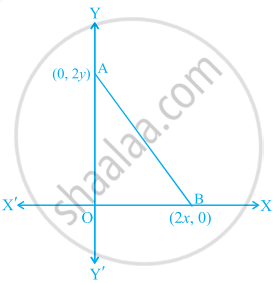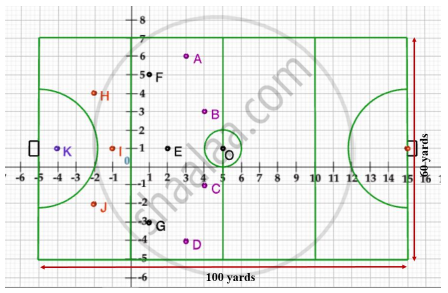Advertisements
Advertisements
प्रश्न
Find the point on the x-axis which is equidistant from (2, -5) and (-2, 9).
उत्तर १
We have to find a point on x-axis. Therefore, its y-coordinate will be 0.
Let the point on x-axis be (x, 0)
Distance between (x, 0) and (2, -5) = `sqrt((x-2)^2+(0-(-5))^2)`
= `sqrt((x-2)^2+(5)^2)`
Distance between (x, 0) and (-2, -9) = `sqrt((x-(-2))^2+(0-(-9))^2)`
= `sqrt((x+2)^2+(9)^2)`
By the given condition, these distances are equal in measure.
`sqrt((x-2)^2 +(5)^2)`
= `sqrt((x+2)^2+(9)^2)`
= (x - 2)2 + 25 = (x + 2)2 + 81
= x2 + 4 - 4x + 25
= x2 + 4 + 4x + 81
8x = 25 - 81
8x = -56
x = -7
Therefore, the point is (−7, 0).
उत्तर २
Let (x, 0) be the point on the x axis. Then as per the question, we have
⇒ `sqrt((x-2)^2 +(0+5)^2)`
⇒ `sqrt((x+2)^2 + (0-9)^2)`
⇒ `sqrt((x-2)^2 +(5)^2)=sqrt((x+2)^2 + (9)^2)`
⇒ (x - 2)2 + (5)2 = (x + 2)2 + (-9)2 ...(Squaring both sides)
⇒ x2 - 4x + 4 + 25 = x2 + 4x + 4 + 81
8x = 25 - 81
8x = -56
x = -7
Therefore, the point is (−7, 0).
संबंधित प्रश्न
If the point P(2, 2) is equidistant from the points A(−2, k) and B(−2k, −3), find k. Also find the length of AP.
Find the distance between two points
(i) P(–6, 7) and Q(–1, –5)
(ii) R(a + b, a – b) and S(a – b, –a – b)
(iii) `A(at_1^2,2at_1)" and " B(at_2^2,2at_2)`
Using the distance formula, show that the given points are collinear:
(1, -1), (5, 2) and (9, 5)
For what values of k are the points (8, 1), (3, –2k) and (k, –5) collinear ?
Find the distance between the following pair of point in the coordinate plane :
(5 , -2) and (1 , 5)
Find the distance between the following pairs of point in the coordinate plane :
(13 , 7) and (4 , -5)
Find the distance of a point (12 , 5) from another point on the line x = 0 whose ordinate is 9.
Prove that the following set of point is collinear :
(5 , 1),(3 , 2),(1 , 3)
Prove that the following set of point is collinear :
(4, -5),(1 , 1),(-2 , 7)
In what ratio does the point P(−4, y) divides the line segment joining the points A(−6, 10) and B(3, −8)? Hence find the value of y.
Prove that the points P (0, -4), Q (6, 2), R (3, 5) and S (-3, -1) are the vertices of a rectangle PQRS.
Show that the points A (5, 6), B (1, 5), C (2, 1) and D (6, 2) are the vertices of a square ABCD.
Show that the points (0, –1), (8, 3), (6, 7) and (– 2, 3) are vertices of a rectangle.
Show that A(1, 2), (1, 6), C(1 + 2 `sqrt(3)`, 4) are vertices of a equilateral triangle
The distance between the points (0, 5) and (–5, 0) is ______.
The coordinates of the point which is equidistant from the three vertices of the ΔAOB as shown in the figure is ______.

A circle drawn with origin as the centre passes through `(13/2, 0)`. The point which does not lie in the interior of the circle is ______.
Case Study -2
A hockey field is the playing surface for the game of hockey. Historically, the game was played on natural turf (grass) but nowadays it is predominantly played on an artificial turf.
It is rectangular in shape - 100 yards by 60 yards. Goals consist of two upright posts placed equidistant from the centre of the backline, joined at the top by a horizontal crossbar. The inner edges of the posts must be 3.66 metres (4 yards) apart, and the lower edge of the crossbar must be 2.14 metres (7 feet) above the ground.
Each team plays with 11 players on the field during the game including the goalie. Positions you might play include -
- Forward: As shown by players A, B, C and D.
- Midfielders: As shown by players E, F and G.
- Fullbacks: As shown by players H, I and J.
- Goalie: As shown by player K.
Using the picture of a hockey field below, answer the questions that follow:

The coordinates of the centroid of ΔEHJ are ______.
Case Study -2
A hockey field is the playing surface for the game of hockey. Historically, the game was played on natural turf (grass) but nowadays it is predominantly played on an artificial turf.
It is rectangular in shape - 100 yards by 60 yards. Goals consist of two upright posts placed equidistant from the centre of the backline, joined at the top by a horizontal crossbar. The inner edges of the posts must be 3.66 metres (4 yards) apart, and the lower edge of the crossbar must be 2.14 metres (7 feet) above the ground.
Each team plays with 11 players on the field during the game including the goalie. Positions you might play include -
- Forward: As shown by players A, B, C and D.
- Midfielders: As shown by players E, F and G.
- Fullbacks: As shown by players H, I and J.
- Goalie: As shown by player K.
Using the picture of a hockey field below, answer the questions that follow:

If a player P needs to be at equal distances from A and G, such that A, P and G are in straight line, then position of P will be given by ______.
|
In a GPS, The lines that run east-west are known as lines of latitude, and the lines running north-south are known as lines of longitude. The latitude and the longitude of a place are its coordinates and the distance formula is used to find the distance between two places. The distance between two parallel lines is approximately 150 km. A family from Uttar Pradesh planned a round trip from Lucknow (L) to Puri (P) via Bhuj (B) and Nashik (N) as shown in the given figure below.
|
Based on the above information answer the following questions using the coordinate geometry.
- Find the distance between Lucknow (L) to Bhuj (B).
- If Kota (K), internally divide the line segment joining Lucknow (L) to Bhuj (B) into 3 : 2 then find the coordinate of Kota (K).
- Name the type of triangle formed by the places Lucknow (L), Nashik (N) and Puri (P)
[OR]
Find a place (point) on the longitude (y-axis) which is equidistant from the points Lucknow (L) and Puri (P).

